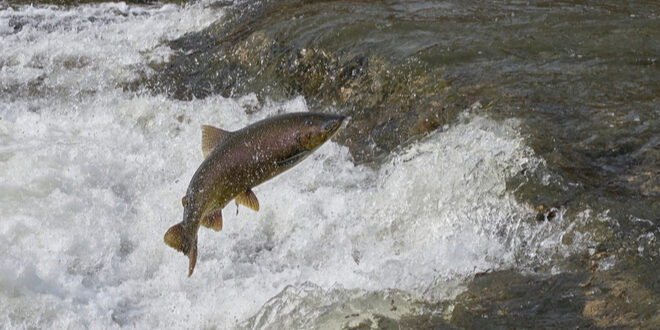The Department of Water Resources (DWR) and Department of Fish and Wildlife (CDFW) are actively working to respond to drought and climate change impacts on native species and ecosystems. Collaborating through shared projects, funding, and research efforts, DWR and CDFW are identifying critical challenges facing salmon and using the best available science and technology to find ways to promote salmon health and survival.
The state has embarked on dozens of projects to ensure the success of California’s salmon populations. These projects include restoring critical habitat for salmon and other fish species, improving salmon migration corridors to and from the ocean, and increasing monitoring efforts to better track the status of populations and devise new strategies to improve their status.
Among the recent highlights:
- In April, DWR and CDFW staff began work to remove vegetation from a key migratory path for adult spring-run Chinook salmon in the Sutter Bypass that runs parallel to the Sacramento River southwest of the Sutter Buttes. Each year, from February through June, salmon migrate through the East Borrow canal of the bypass on their way to spawning grounds near Chico. Waters are warmer in the bypass because of the severe drought and changing climate, and that has resulted in extensive overgrowth of aquatic vegetation that impedes adult salmon migration. DWR and CDFW scientists are working together to clear this migration pathway and ensure improved mobility and water quality for migrating adult spring-run Chinook salmon returning to their spawning grounds. A video of the project is available on the DWR YouTube channel.
- Further up the Sacramento River, returning salmon will find a new side channel with gravel suitable for spawning and riverbank vegetation to help reduce water temperatures. The warming climate and dry conditions are leading to increased river temperatures that can have fatal consequences for salmon. The new side channel was designed by DWR engineers and constructed by a tribal contractor near Anderson at a location where DWR and CDFW scientists observed numerous salmon taking advantage of the calmer waters to spawn. The side channel doubles as a place where juveniles can grow and thrive after hatching and emerging from the gravel. Similar activities to improve spawning locations through the application of suitable gravel have occurred in the Feather River, the Sacramento River’s largest tributary, and more are being planned.
- Also underway along two tributaries of the Sacramento River in Tehama County is an enhanced research and monitoring project for spring-run juvenile salmon in Mill and Deer creeks by CDFW biologists under funding by DWR. These are two of a handful of streams in the Central Valley that still support the unique yearling-type juvenile salmon, which remain in the waterbody after hatching for nearly a year before beginning downstream migration and are believed to be the only salmon from these two streams that survive drought conditions and eventually return to spawn. Yearling-type juvenile salmon were plentiful in streams across the Central Valley prior to dam construction and were likely a key factor in the resiliency of Central Valley salmon populations.
- A major multi-agency effort is underway to assist migration of winter- and spring-run adults and juveniles around reservoirs on the Upper Sacramento River so they can access historical spawning and rearing-habitat in tributaries above Shasta Reservoir, habitat that has been inaccessible for decades since dam construction. This summer, DWR and CDFW will participate in a multi-agency, multi-stakeholder effort to test a system to collect juvenile salmon as they make their way downstream – a critical component of the assisted migration process. This and other similar relocation projects are being considered as one of many ways to help ensure Central Valley salmon persist through the extended droughts predicted for California’s future.
- State, federal, and university scientists are working to uncover new information and develop new actions to support and protect California’s salmon. For the last two years, scientists observed that many baby salmon are dying before they hatch, or shortly thereafter, and discovered the cause was a thiamine deficiency in their parents resulting from a shift in the ocean food web, a phenomenon recently observed in a number of fish populations around the globe. While a simple thiamine bath has proven effective in alleviating this deficiency in hatchery fish, naturally spawning salmon in the rivers continue to be heavily impacted. Last spring, DWR and CDFW began thiamine treatments on the large number of adult spring-run salmon that pass through the Feather River Fish Hatchery but are released back into the river to spawn in an effort to help this already drought-stricken salmon population weather the period of altered ocean conditions.
These projects are a few examples of many long-term collaborations among federal, state, local, non-governmental, tribal, and academic partners that have joined forces to support salmon survival.
To learn more about collaborative projects protecting salmon populations, visit the DWR website highlighting these efforts and more. Additional projects will be featured throughout the summer.
 California Water News Daily Your Source For Water News in California
California Water News Daily Your Source For Water News in California


